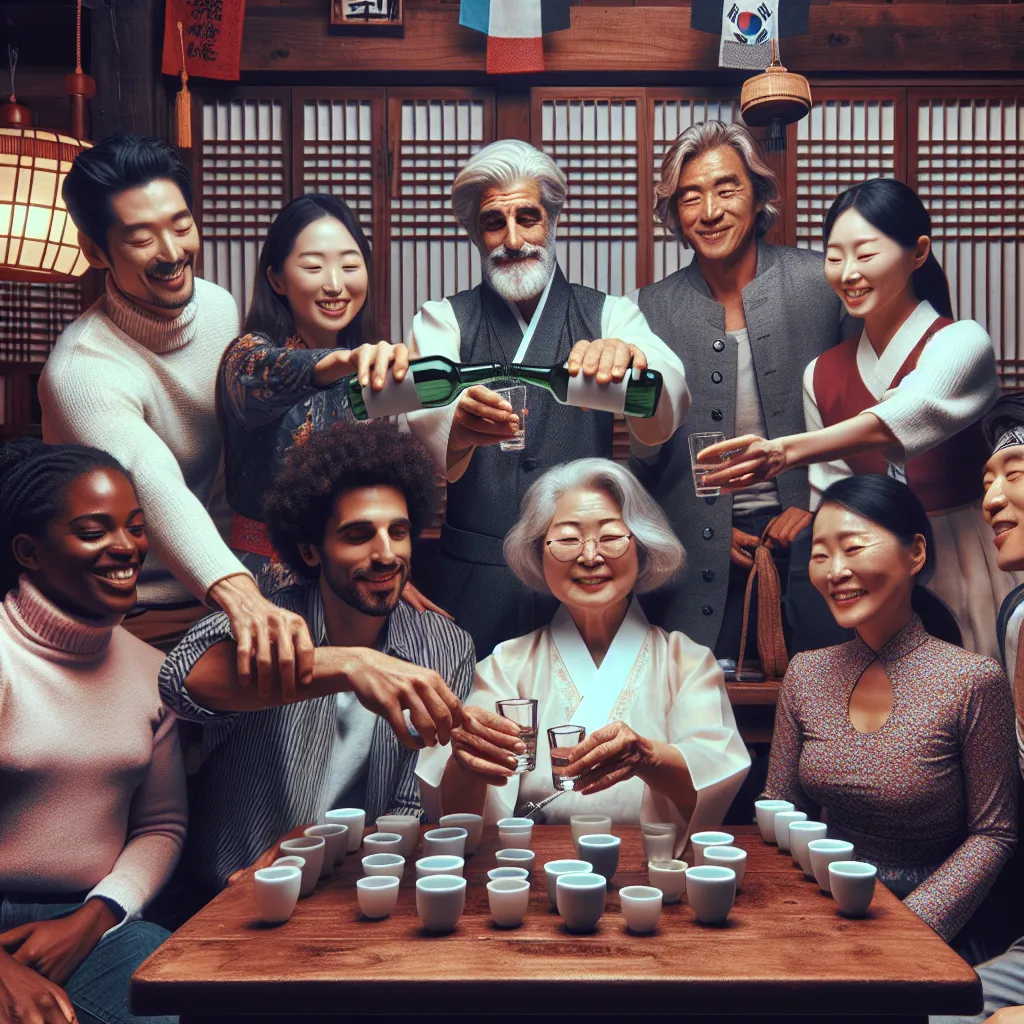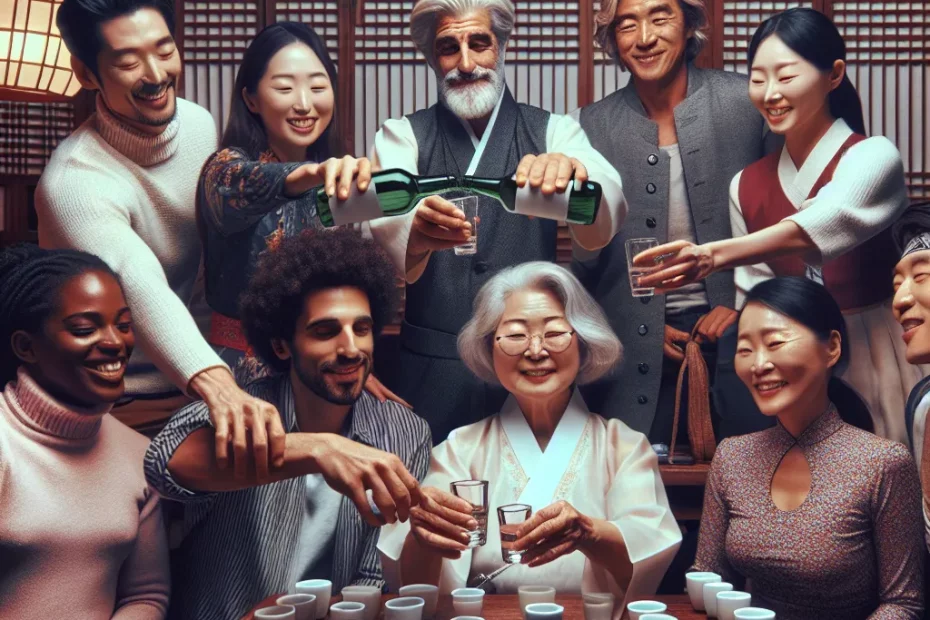In the vibrant social scene of Korea, drinking etiquette plays a crucial role in fostering relationships and showing respect. Understanding the intricacies of Korean drinking culture is essential for both locals and visitors alike. From the significance of age hierarchy to the proper ways of pouring and receiving drinks, each aspect reflects the values and traditions deeply rooted in Korean society. Moreover, knowing how to gracefully refuse alcohol while still maintaining politeness is a skill that can navigate social situations with finesse. By delving into the nuances of Korean drinking etiquette, one can gain a deeper appreciation for the cultural tapestry that shapes interactions in this dynamic society.

Introduction to Korean Drinking Culture
In the vibrant and dynamic social scene of South Korea, the tradition of drinking holds a significant place. Korean drinking culture is deeply rooted in history and tradition, reflecting the values and customs of the Korean people. Understanding the etiquette and practices associated with drinking in Korea is essential for anyone looking to fully immerse themselves in the rich tapestry of Korean social life.
The Concept of “Hoesik”
One of the key aspects of Korean drinking culture is the concept of “hoesik,” which refers to the practice of going out for drinks with colleagues or friends after work. Hoesik is not just about drinking; it is a time for bonding, building relationships, and fostering camaraderie. In this setting, hierarchy plays a crucial role, with the most senior person typically leading the proceedings and setting the tone for the evening.
Etiquette for Pouring Drinks
When it comes to pouring drinks in Korea, there are certain etiquettes to keep in mind. It is customary for the younger or more junior person to hold the bottle with two hands when pouring a drink for an elder or senior. This gesture shows respect and is considered a sign of good manners. Additionally, it is polite to turn away or cover your mouth with your hand when taking a shot of soju, a popular Korean alcoholic beverage.
Group Dynamics and Communal Drinking
Korean drinking culture also places a strong emphasis on group dynamics and communal drinking. It is common for everyone at the table to participate in group activities such as “anju,” which are shared dishes served alongside alcoholic beverages. Anju not only enhances the drinking experience but also encourages interaction and conversation among the group.
The Practice of “Bottoms Up”
Furthermore, the practice of “bottoms up” is prevalent in Korean drinking culture, especially during celebratory occasions or when toasting. When someone offers a toast, it is customary to finish your drink in one shot as a sign of respect and appreciation. This act is often accompanied by enthusiastic cheers and expressions of goodwill.
In conclusion, Korean drinking culture is a fascinating and integral part of Korean social life. By understanding and embracing the customs and etiquettes associated with drinking in Korea, one can truly appreciate the depth of Korean hospitality and camaraderie. So, raise your glass, say “geonbae,” and immerse yourself in the vibrant world of Korean drinking culture! 🍻✨
The Importance of Age Hierarchy in Drinking
In Korean culture, age hierarchy plays a crucial role in social interactions, especially when it comes to drinking. The concept of “age is authority” is deeply ingrained in Korean society, and this is particularly evident in the drinking culture. When Koreans gather for a drinking session, the age of each individual determines their position in the hierarchy, which in turn dictates the dynamics of the group.
Order of Pouring and Receiving Drinks
One of the key aspects of age hierarchy in drinking is the order in which drinks are poured and received. It is customary for the youngest member of the group to pour drinks for the older members as a sign of respect. This act of pouring drinks, known as “ggaebeom” in Korean, symbolizes the younger individual’s acknowledgment of the older person’s authority and experience.
Consumption Etiquette
Moreover, the way in which drinks are consumed also follows the age hierarchy. Younger members are expected to turn away or cover their mouths while drinking in the presence of older individuals as a sign of politeness and humility. This gesture demonstrates the younger person’s deference to the older members of the group.
Language and Mannerisms
Age hierarchy in drinking also influences the language and mannerisms used during the drinking session. Younger individuals are expected to use honorific speech and show proper etiquette when addressing their elders. Failure to do so can be seen as a sign of disrespect and may lead to strained relationships within the group.
Cultural Reflection
The importance of age hierarchy in drinking extends beyond just social interactions; it also reflects broader cultural values such as respect for elders, hierarchical relationships, and the importance of maintaining harmony within a group. By adhering to these age-based norms in drinking settings, Koreans reinforce the traditional values that have shaped their society for centuries.
In conclusion, the concept of age hierarchy in drinking is a fundamental aspect of Korean culture that influences social dynamics, behavior, and relationships. By understanding and respecting these age-based norms, individuals can navigate social situations with grace and contribute to the harmony of the group.
Proper Ways to Pour and Receive Drinks
Pouring Drinks:
When pouring drinks for others in a Korean setting, there are several key points to keep in mind. Firstly, always use both hands to hold the bottle or the decanter as a sign of respect. This gesture shows that you are offering the drink wholeheartedly and with good intentions. Secondly, when pouring soju or other alcoholic beverages, it is customary to pour with your right hand while lightly supporting your right forearm with your left hand. This technique not only shows respect but also prevents any spills or accidents.
In addition, the level of the glass when pouring is crucial. The glass should be placed on the table, and the person pouring should hold the bottle at a reasonable height to prevent splashing. Aim to fill the glass about two-thirds full, as it signifies generosity without overwhelming the drinker. Lastly, never pour your own drink; instead, wait for others to pour for you, and reciprocate the gesture when the opportunity arises.
Receiving Drinks:
On the receiving end, there are also etiquettes to observe when accepting a drink in Korean culture. When receiving a drink, hold the glass with both hands as a sign of appreciation and respect. It is polite to turn your head slightly to the side when receiving a drink, especially from someone older or of higher status. This gesture shows humility and gratitude for the gesture.
After receiving the drink, it is customary to take a small sip rather than emptying the glass in one go. This allows for multiple toasts throughout the evening and maintains a convivial atmosphere. When clinking glasses during a toast, it is common to make eye contact with the person you are toasting to, further emphasizing the bond between individuals.
By adhering to these traditional customs of pouring and receiving drinks in Korean culture, you not only show respect for the customs and traditions but also deepen your connections with those around you. So, the next time you find yourself in a Korean social setting, remember these etiquettes to navigate the experience with finesse and cultural sensitivity!
Cheers to a delightful and respectful drinking experience!
Etiquette for Refusing Alcohol in Korea
In Korean culture, drinking alcohol is often seen as a way to bond and build relationships. However, there may be times when you need to politely decline an offer of alcohol. Understanding the etiquette for refusing alcohol in Korea is essential to navigate social situations gracefully.
Polite Ways to Refuse Alcohol
When refusing alcohol in Korea, it is important to do so with respect and consideration. You can politely decline by saying, “고맙지만 제가 술을 마시지 않아요” (Thank you, but I don’t drink alcohol). This simple phrase shows your appreciation for the offer while clearly stating your decision not to drink.
Offering a Reason
It is also common to offer a valid reason for not drinking, such as health concerns or personal preferences. By providing a brief explanation, you show that your refusal is not a reflection on the host or the occasion.
Choosing an Alternative Beverage
In Korean culture, it is considered polite to offer an alternative beverage when refusing alcohol. You can ask for a non-alcoholic option like soda, juice, or water. This gesture shows your willingness to participate in the gathering while respecting your own choices.
Maintaining a Positive Attitude
Additionally, when refusing alcohol in Korea, it is important to maintain a positive attitude and engage in the social interaction. You can still raise your glass for a toast with your non-alcoholic drink or participate in the conversation with enthusiasm. By staying involved in the gathering, you show respect for the host and other guests.
Overall, the key to refusing alcohol in Korea lies in communication and courtesy. By politely declining, offering a reason, choosing an alternative beverage, and staying engaged in the social setting, you can navigate these situations with grace and respect for Korean drinking etiquette. Remember, it is perfectly acceptable to decline alcohol, and your choices should be respected by others. Cheers to a pleasant and respectful social experience in Korea! 🥂
Korean drinking etiquette is deeply rooted in age hierarchy and respect. Proper ways to pour and receive drinks play a significant role in social interactions. Understanding the nuances of refusing alcohol in Korea is crucial in maintaining harmony in drinking situations. These etiquettes not only showcase respect for tradition but also reflect the values of Korean society. By following these customs, one can navigate social gatherings with grace and appreciation for Korean culture.
